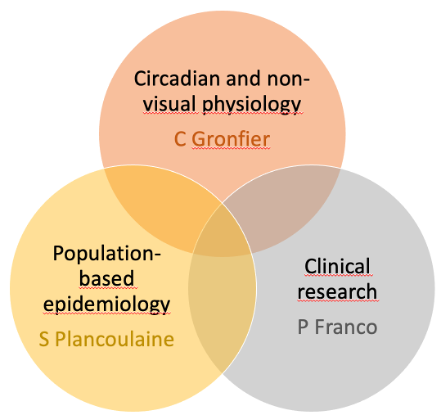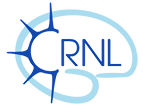
We spend a third of our lives sleeping since the birth of mankind, and yet sleep remains largely a mystery. We learned over the past 30 years that sleep is regulated by two main processes, one called the homeostatic process (sleep pressure), the other one the circadian process (sleep timing). Sleep timing is under the control of an endogenous clock that drives a large number of physiological functions, and that is maintained in synchrony with the 24-hour day by the light-dark cycle. Over the past 10 years, light has appeared, not only as a synchronizer of the circadian clock, but also as a strong regular of wakefulness and sleep. Yet, the neurobiological pathways involved are largely unknown. Sleep and the circadian clock are also influenced by the environment, but whether and how life conditions can predict health hasn’t been precisely investigated. In our group, structured around a combination of unique complementary expertise, and we develop three research axes aimed at studying:
1) the mechanisms of non-visual and circadian regulation of sleep and wakefulness (C. Gronfier),
2) how sleep and circadian physiology are influenced by real life conditions and can be predictors of future health (S. Plancoulaine),
3) what sleep/circadian pathologies can contribute to the understanding of mechanisms and the development of innovative therapeutic approaches (P. Franco).
The group is currently composed of 28 people, including 6 permanent researchers/PUPH/MCUPH/PH, 4 postdocs, 8 PhD students, 2 ITA, and 8 fellows. Four more people are to be recruited (funding obtained) by the end of 2023.
Overview of the research conducted in our subgroups (see individual pages of theme leaders for more details):
- Mechanisms of non-visual and circadian regulation of sleep and wakefulness (C. Gronfier):
Our research objectives are articulated in 3 complementary cross-talking axes:
- The neurobiological mechanisms involved in circadian and non-visual (NV) physiology and responses to light. In this axe, we investigate circadian/photobiological mechanisms in adults, in children (in collaboration with P Franco), and neurotransmission in unique animal models (in collaboration with JS Lin).
- How real-life conditions (photic environment) impact timed physiology. Here, we want to understand light exposure in real life may be involved in improper entrainment/synchronization of the circadian system and may lead to troubles and diseases (in collaboration with S Plancoulaine).
- How pathologies can lead to ill-timed physiology, and alterations of non-visual physiology to pathologies. Here we collaborate with clinicians, in the group (P Franco), in the CRNL (F Gobert, J Luauté), and outside.
- How sleep and circadian physiology are influenced by real life conditions and can be predictors of future health (S Plancoulaine),
Our research objectives are articulated in 4 complementary axes:
- Describe the sleep characteristics (duration, quality, rhythms) overtime in different populations and in particular with the modeling of specific trajectories or groups of trajectories from birth to adulthood.
- Identify factors explaining the different sleep characteristics in the different populations in order to identify specific levers for sleep interventions and prevention
- Characterize how sleep characteristics explain later health markers to better understand the implication of sleep and to argue the need of sleep prevention
These first three axes are mainly based on French birth cohorts but also on specific populations such as children with sleep disorders (in collaboration with P Franco) or adult volunteers or shift-workers (in collaboration with C. Gronfier). The third axis often involves collaborations with colleagues outside CRNL.
- Implement sleep interventions in children and adolescents on specific identified levers to modify (and assess) sleep characteristics and subsequent health markers. Here we collaborate with colleagues within CRNL (S Mazza, A Rey), and outside.
- what sleep/circadian pathologies can contribute to the understanding of mechanisms and the development of innovative therapeutic approaches
Our research objectives are articulated in 3 complementary cross-talking axes:
- How impairments in awakening systems (orexin, histamine, serotonin) could influence the clinical, electrophysiological, metabolic and cognitive characteristics in pathologies such as pediatric narcolepsy and Sudden infant death syndrome (in collaboration with JS Lin, and other colleagues)? These studies have lead to therapeutic solutions for narcolepsy (inverse antagonist H3 , Pitolisant) and to the research of genetic makers for the prevention of SIDS (BIOMINRISK 2023).
- How the prenatal, postnatal factors or congenital conditions (Pierre Robin & Prader Willi syndromes (with L. Coutier), Down syndrome (external collaboration) could influence sleep structure, autonomic function and cognitive outcome in children?
- Are there electrophysiological, cognitive or biomarkers for insomnia in young children (collaboration with B. Putois) and for excessive daytime sleepiness (collaboration with L. Seugnet, V. Herbillon, JP Lachaux) ?
- Is the circadian system involved in disorders outside the classical circadian rhythm sleep disorders (i.e., autism, narcolepsy, Smith Magenis syndrome, alternating Hemiplegia) ? This would provide new mechanistic pathways and therapeutic targets (in collaboration with C. Gronfier and colleagues from the HCL and the Vinatier).











